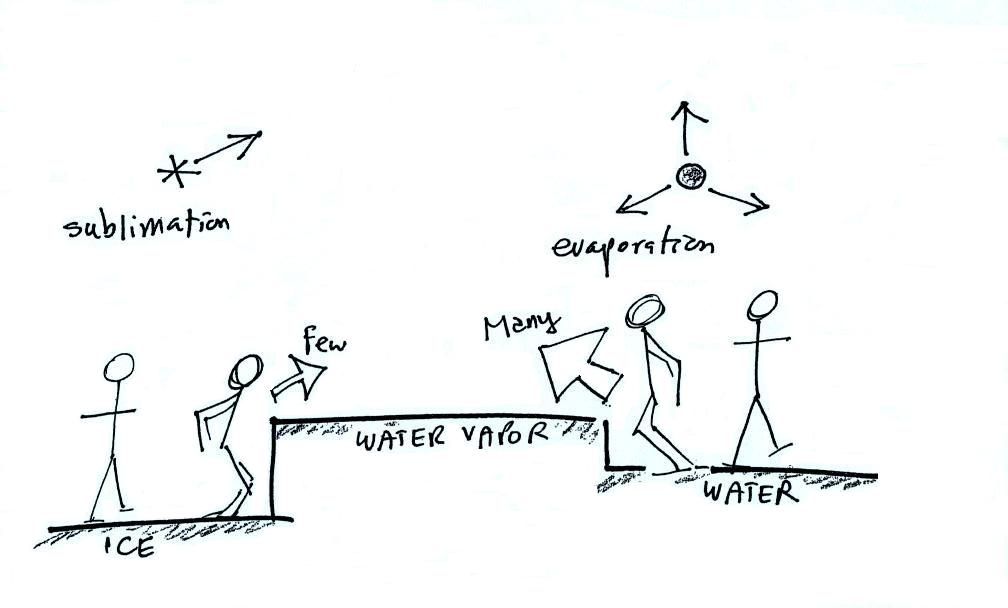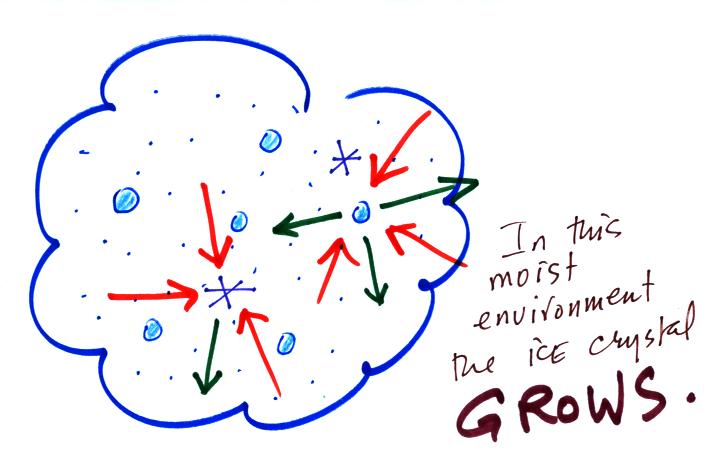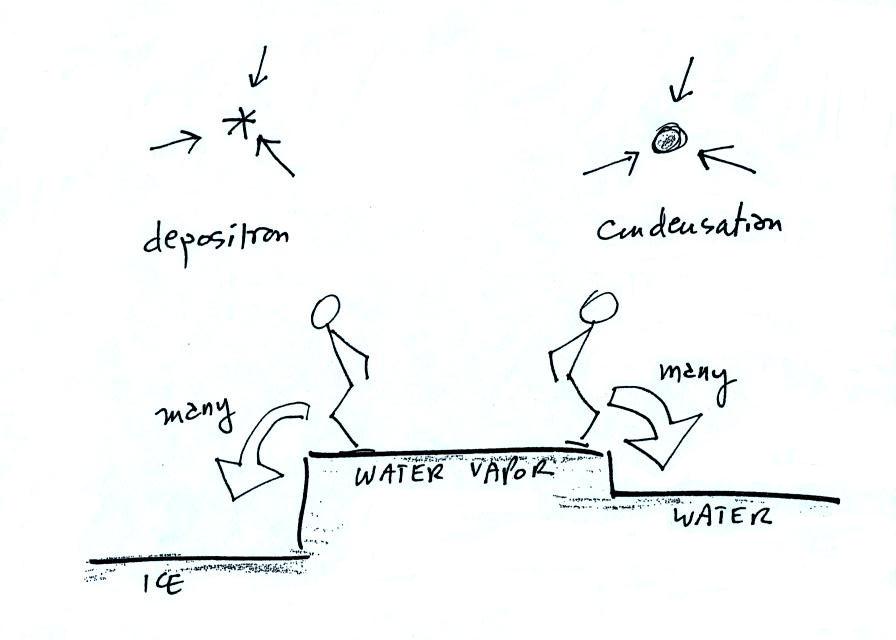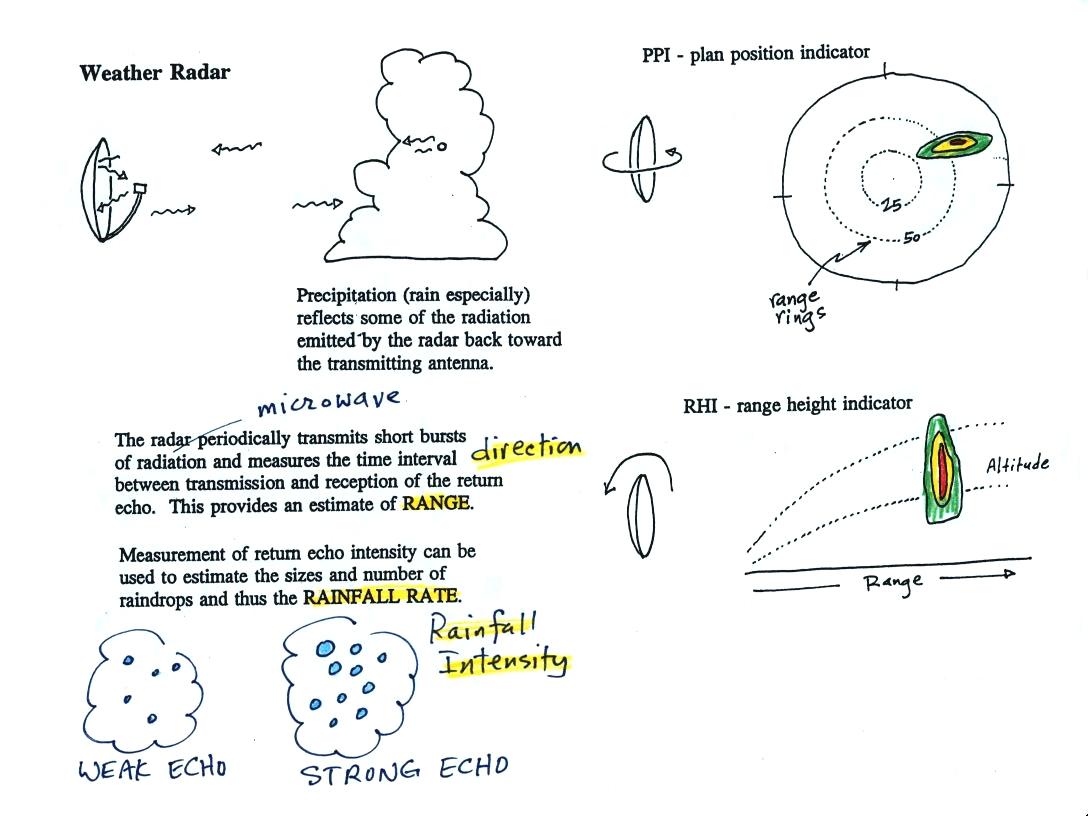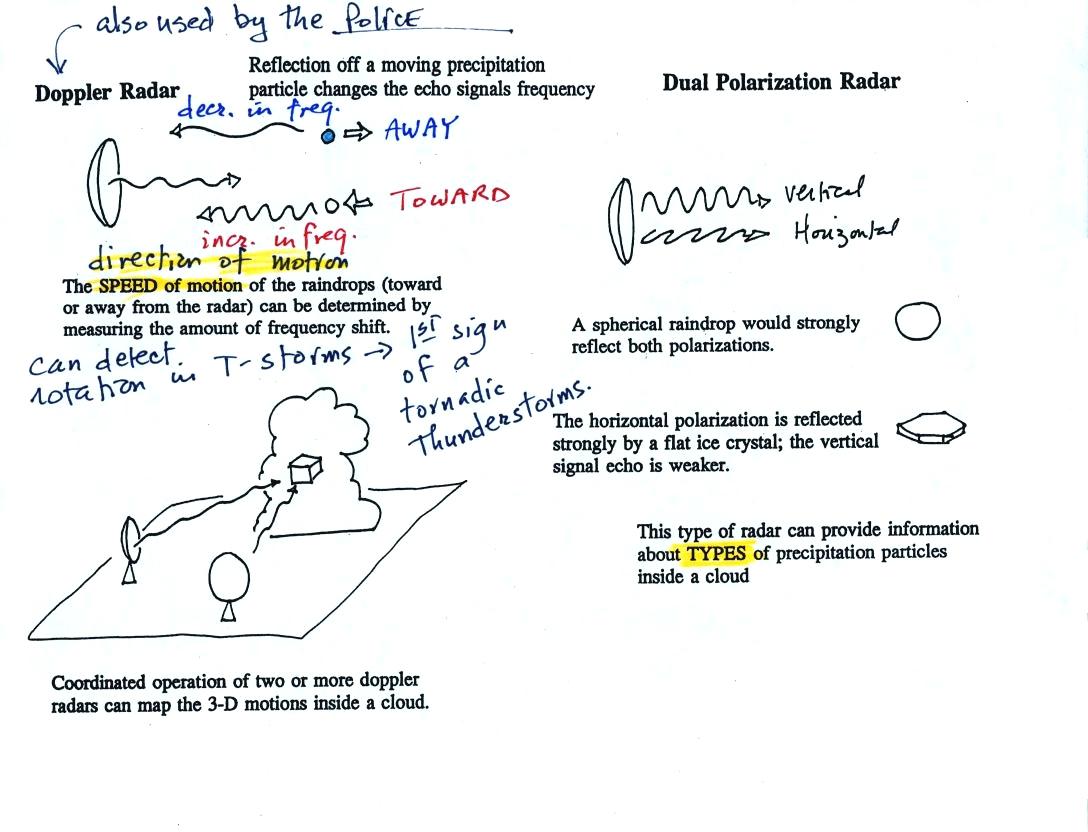In the last lecture we learned that the ice crystal
process works
in the middle part of a cold cloud where there is a mixture of ice
crystals and lots of supercooled water droplets. Now we'll see
how ice crystals can quickly grow in that environment into
precipitation size particles.
This first figure above
shows a water droplet in equilibrium with its surroundings..The droplet
is evaporating (the 3 blue arrows in the figure). The rate of
evaporation will depend on the temperature of the water droplet.
The droplet is surrounded by air that is saturated with water vapor
(the droplet is inside a cloud where the relative humidity is
100%). This means there is enough water vapor to be able to
supply 3 arrows of condensation. Because the droplet loses and
gains water vapor at equal rates it doesn't grow or shrink.

This figure shows what is required
for an ice crystal (at
the same
temperature) to be in equilibrium with its surroundings. First,
the ice crystal won't evaporate as rapidly as the water droplet (only 1
arrow is shown). Going from ice to water vapor is a bigger
jump than going from water to water vapor. There won't be as many
ice molecules with enough energy to make that jump. A sort of
analogous situation is shown in the figure below. The class
instructor could and most of the people in a classroom could jump from
the
floor to the top of a 12 or 15 inch tall box. It would be much
tougher to jump to the top of the cabinet (maybe 30 inches off the
ground). There wouldn't be as many people able to do that.
To be in equilibrium the ice crystal only needs 1 arrow of
condensation. There doesn't need to be as much water vapor in the
air surrounding the
ice crystal to supply this lower rate of condensation.
Now what happens in the mixed phase region of a cold cloud
is that
ice crystals find themselves in the very moist surroundings needed for
water droplet equilibrium. This is shown below.
The water droplet is in equilibrium (3 arrows of evaporation
and 3
arrows of condensation) with the surroundings. The ice crystal is
evaporating more slowly than the water droplet. Because the ice
crystal is in the same surroundings as the water droplet water vapor
will be condensing onto the ice crystal at the same rate as onto the
water droplet. The ice
crystal isn't in equilibrium, condensation
(3 arrows) exceeds evaporation (1 arrow) and the ice crystal will
grow. That's
what makes the ice crystal process work.
The equal rates of condensation are shown in the figure
below using the
earlier analogy.
Most everyone can manage to make the big or the small jump.
Now
we
will
see
what
can
happen
once the ice crystal has had a chance to
grow a little bit.

Once an ice
crystal has grown a
little bit it becomes a snow crystal (this figure is on p. 102 in the
photocopied classnotes). Snow crystals can have a variety of
shapes
(plates, dendrites, columns, needles, etc.; these are called crystal
habits) depending on the conditions (temperature and
moisture)
in the cloud. Dendrites are the most common because they form
where there
is the most moisture available for growth. With more raw material
available it makes sense there would be more of this particular snow
crystal
shape.
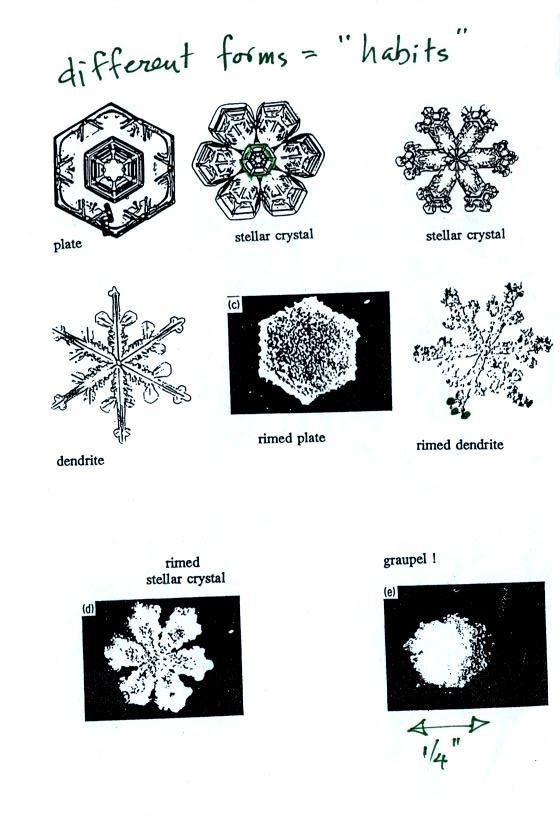
Here are some actual photographs of snow crystals (taken with a
microscope). Snow crystals are usually 100 or a few 100s of
micrometers
in diameter (tenths of a millimeter in diameter). The different
shapes are called "habits", I probably didn't mention that in class.
You'll find some much better photographs and a pile of addtional
information
about snow crystals at www.snowcrystals.com

A
variety of things can happen once a snow crystal forms. First it
can
break into pieces, then each of the pieces can grow into a new snow
crystal. Because snow crystals are otherwise in rather short
supply, ice
crystal multiplication is a way of increasing the amount of
precipitation that
ultimately falls from the cloud.

Several snow
crystals can collide
and stick together to form a snowflake. Snow crystals are small,
a few
tenths of a millimeter across. Snowflakes can be much larger and
are made
up of many snow crystals stuck together. The sticking together or
clumping together of snow crystals is called aggregation (I frequently
forget this term. If I can't
remember it I don't expect you to remember it either)

Snow crystals can
collide with supercooled water droplets. The
water
droplets may stick and freeze to the snow crystal. This process
is called
riming or accretion (note this isn't called collision coalescence even
though
it is the same idea). If a snow crystal collides with enough
water
droplets it
can be completely covered with ice. The resulting particle is
called
graupel. Graupel is sometimes mistaken for hail
and is
called soft hail or snow pellets. Rime ice has a frosty milky
white
appearance. A graupel particle resembles a miniature snow
ball.
Graupel particles often serve as the nucleus for a hailstone.
This figure gives you an idea of how hail forms.
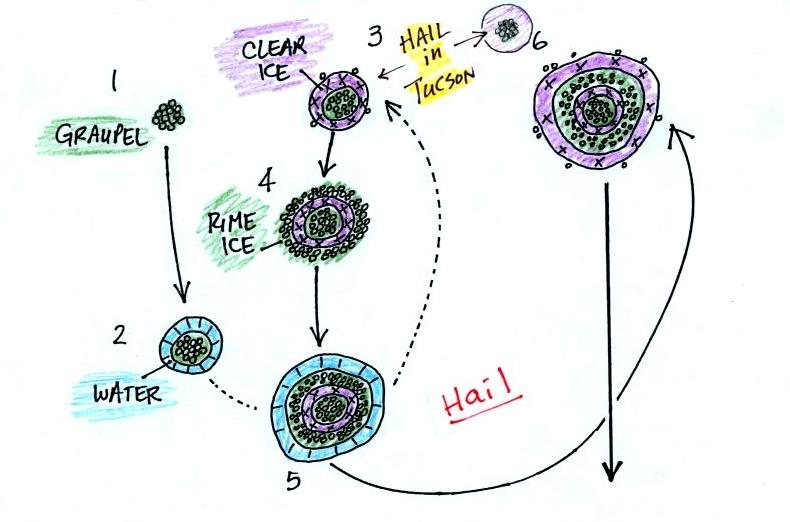
In the figure
above a hailstone
starts with a graupel particle (Pt. 1, colored green to represent rime
ice). The
graupel falls or gets carried into a part of the cloud where it
collides with a
large number of supercooled water droplets which stick to the graupel
but don't
immediately freeze. The graupel gets coated with a layer of water
(blue) at Pt. 2. The particle then moves into a colder part of
the cloud
and the
water layer freeze producing a layer of clear ice (the clear ice,
colored
violet, has a distinctly different appearance from the milky white rime
ice), Pt. 3. In Tucson this is often the only example of hail that you
will see:
a graupel particle core with a single layer of clear ice.
In the severe thunderstorms in the Central Plains, the hailstone can
pick up a
new layer of rime ice, followed by another layer of water which
subsequently
freezes to produce a layer of clear ice.
This cycle can repeat several times; large hailstones can be composed
of many
alternating layers of rime and clear ice. An unusually
large
hailstone (around 3 inches in diameter) has been cut in half to show
(below)
the different layers of ice. The picture below is close to actual
size.

Hail is produced
in strong
thunderstorms with tilted updrafts. You would never see hail
(or graupel) falling from a nimbostratus cloud.

The growing
hailstone can fall
back into the updraft (rather than falling out of the cloud) and be
carried
back up toward the top of the cloud. In this way the hailstone
can
complete several cycles through the interior of the cloud.
One last figure showing some of the things that can happen once a
precipitation particle falls from a cloud
Moving from left to right, a falling graupel particle or a snow
flake can move into warmer air and melt. The resulting drops of
water fall the rest of the way to the ground and would be called
RAIN. Note sometimes the grauple will reach the ground before
melting.
Sometimes the falling raindrops will evaporate before reaching the
ground. This is called VIRGA and is pretty common early in the
summer thunderstorm season in Arizona when the air below the
thunderstorm is dry.
Lightning that comes from thunderstorms that aren't producing much
precipitation is called "dry lightning" and is a common cause of brush
fires.
Rain will sometimes freeze before reaching the ground. The
resulting particle of clear ice is called SLEET. FREEZING RAIN by
contrast freezes once it reaches the ground. Everything on
the ground can get coated with a thick layer of ice. It is nearly impossible to
drive
during one of these "ice storms." Sometimes the coating of ice
is heavy enough that branches on trees are broken and power lines are
brought
down. It sometimes takes several days for power to be restored.
Satellite
photographs are a good way of observing clouds
(especially out over the ocean). Using both
visible and
infrared light satellite photographs, you can get a good idea of cloud
type. However satellite
photographs don't really tell you whether a cloud is producing
precipitation or how much precipitation a cloud is producing. For
that you need radar.
In some ways a radar image of a thunderstorm is
like an
X-ray photograph which provides a partial view of the insides of a
human body. The Xrays
pass through the flesh but are partially absorbed by bone.
The
radio signals
emitted by radar
pass through the cloud itself but are reflected by the much larger
precipitation particles. The intensity of the reflected signal
(the echo) depends on the number and the size of the precipitation
particles. Red generally means an intense reflected signal
and heavy precipitation. The edge of the cloud
isn't normally seen on the radar signal.
Weather radar can be used in a variety of ways. An
ordinary
radar
periodically transmits a short burst of
microwave
radiation. The radar keeps
track of what direction
the antenna is pointing and determines how long it takes for a signal
to go out and return.
Conventional radar can thus determine the
direction and distance to a precipitating cloud and make an estimate of
the rainfall rate or intensity.
The radar antenna slowly spins as it is transmitting so it
scans a full
360 degrees of azimuth in a minute or two. Information
from
a
single radar or a combination of data from many
radars are drawn on weather maps (the PPI display above shows the data
from a single radar, the radar would be at the center of the
picture).
The radar antenna can also be pointed at an interesting storm and the
radar antenna can then be caused to scan vertically through the
storm. This produces the RHI display shown in the figure above.
By detecting changes in the frequency of the reflected
signal, a
doppler radar can measure the speed at which precipitation particles
are moving toward or away from a radar antenna. By combining data
from 2 or more radars (and some complicated computer processing),
three-dimensional wind motions inside a cloud can be mapped out.
Doppler radars can detect a rotating thunderstorm updraft (a
mesocyclone) that could indicate a thunderstorm capable of producing
tornadoes. Small mobile doppler radars are being used to try to
measure wind speeds in tornadoes. Police use doppler radar to
measure the speeds of automobiles on the highway (moving toward or away
from the police car).
Dual polarization radar is a research tool that can be used
to learn something about the kinds of
precipitation particles inside a cloud.



